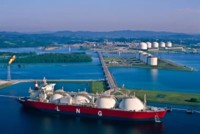Boom or Bust: Assessing Canada's LNG Future
 Joint ventures (JVs) and partnerships could make all the difference between capitalizing on global liquefied natural gas (LNG) opportunities in Asian demand markets and losing ground to foreign suppliers, says a new Canadian Ernst & Young report.
Joint ventures (JVs) and partnerships could make all the difference between capitalizing on global liquefied natural gas (LNG) opportunities in Asian demand markets and losing ground to foreign suppliers, says a new Canadian Ernst & Young report.According to the new report, Rising to new challenges in the face of global demand: liquefied natural gas in Canada , countries around the world are capitalizing on Asian LNG demand and fast becoming powerful threats to potential Canadian market share.
“Total Pacific basin demand is expected to rise from 120 million metric tonnes today to 241 million metric tonnes per annum in 2020, and exporters in Australia, Russia, Malaysia and Qatar have been quick to respond,” says Lance Mortlock, of Ernst & Young’s oil and gas practice.
“These countries are already well on track to developing the necessary infrastructure to fulfill the needs of this expanding market - leaving little room for Canada.”
Seven US LNG terminals have also been filed for application, which, if approved and built, could put them ahead of Qatar in export capacity, changing the regional dynamics in Asia significantly.
Ernst & Young’s findings reflect views widely accepted in BC and by the federal government. Capturing LNG markets in Asia where gas prices are triple those in Canada can only be captured if Canada takes the necessary steps and invests massively in LNG infrastructure, such as our competitors including the United States and Australia are doing as noted in the report.
While Canada has immense domestic gas reserves, there is limited domestic demand to consume the available supply. Adding reduced demand from the US - Canada’s only external customer - following the shale boom as well as sustained low gas prices, reveals that Canada is facing limited opportunities for LNG development.
“To avoid losing out on opportunities in emerging demand markets, Canada must accelerate infrastructure development, seek new capital sources, and tie down long-term customers,” says Mortlock.
An estimated CDN$50-billion industry investment is expected to be needed over the next 5 to 10 years if Western Canadian producers are to take full advantage of opportunities in Asia. But LNG projects can be too big and too risky for companies to tackle on their own.
Companies must consider the various aspects of their business operating model, including strategy, business processes, information systems, structure and governance, leadership people management and corporate culture, says the report.
Ernst & Young predicts Canada could have about 12 million metric tonnes per annum (mmtpa) of LNG export capacity in place by 2015, but Mort-lock cautioned the figure depends on whether U.S. Gulf Coast LNG proponents and other competitors world-wide move in.
The capacity outlook for Canada is just over twice the initial size of the most advanced B.C. proposal, Kitimat LNG, but a small fraction of anticipated future global supply. Qatar, the most ambitious LNG player, has more than six times Canada’s capacity planned by 2015 - at 77 mmtpa - Ernst & Young says according to a report in the Vancouver Sun.
Canada’s capacity to service the growing Asian LNG market hinges on how quickly hundreds of kilometres of pipelines are installed to connect trillions of cubic feet of recoverable shale gas in northeastern B.C.
Construction has not started on any export terminals, in part dues to concerns over environmental impacts and the need to ensure First Nation’s acceptance of the proposed projects.
Another risk factor not stressed in the report but very much on the minds of investors is the fact that Asia LNG markets can and will change on a dime. Russia is a huge wild card here. So is China. Both countries undoubtedly have lots of shale gas and once the infrastructure to mine this shale gas is developed, Canadian market opportunities may be more suspect.
You can return to the main Market News page, or press the Back button on your browser.

